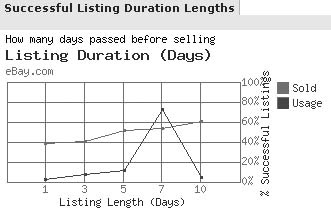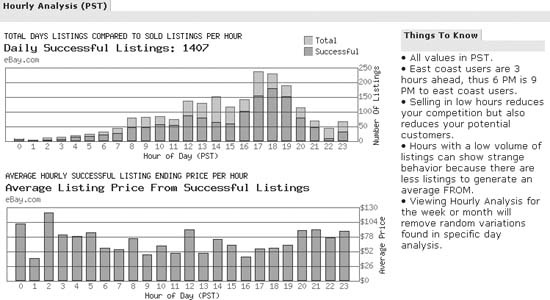Choose the best day of week and time of day to start and end your listing.
Timing is as important in online auctions as it is in comedy. Most of your customers will see and bid on your listing during its last day—and particularly, in its last few minutes—on the auction block. So it stands to reason that you should favor end days and times that are most popular with your customers.
When creating a listing [Hack #43] , you’re given the opportunity to select a listing duration and, for an extra fee, a start time and day, but what you should really be thinking about is the day and time your listing ends.
With an assortment of durations at your fingertips, you have the ability to choose almost any day of the week to end your listing. If only celebrity boxing was this accommodating.
You can choose a 1-, 3-, 5-, 7-, or 10-day listing. eBay charges the same insertion fee for 1-, 3-, 5-, and 7-day listings, but imposes an extra fee [Hack #46] if you want your listing to last 10 days. The duration is important for two reasons: it determines how long your listing is active on eBay (and thus how many customers see it) and, when taking the start day into account, what day of the week your listing ends.
Conventional wisdom holds that the longer the duration, the better. The theory is that the more time a listing is active on eBay, the more bidders will see it, and the more bids you’ll get. In most cases, the extra exposure afforded by the longest duration—especially for rare items—is easily worth the added expense.
But there’s also the implied “urgency” of a short 3-or 5-day auction to consider, which might encourage bidders to bid earlier—and higher. Plus, many sellers feel that longer auctions just unnecessarily postpone the inevitable bidding frenzy on the last day—particularly for common items—and that a duration of 5 or 7 days is just as good as 10, if not better.
Tip
1-day listings, while seemingly pointless for getting the attention of a lot of bidders, are great for time-sensitive listings, such as event tickets and travel tickets. Note that 1-day listings are available only if you have a feedback rating of at least 10 or if you’re ID-verified [Hack #8] .
You also may want to choose a shorter listing duration if you’re not going to be around when a 7-or 10-day listing would end, or if you want last-minute buyers to be able to complete the transaction and receive the product before an upcoming holiday.
The duration you choose is ultimately up to you and should be based on your own experience, patterns, and knowledge of your markets. For instance, if you list a lot of similar items, you’ll want to stagger them so they don’t all end on the same day, both to avoid flooding the market and to preserve your own sanity. Or perhaps you’ll simply settle into a weekly routine of listing on Tuesdays, collecting payments on Saturdays, and shipping on Mondays.
Now, if you start a five-day listing on a Wednesday, it’ll close on the following Monday. The start day is important, because that’s when your listing will appear at the top of search results sorted by time listed. But the end day is even more important, not only because of when it will appear at the top of ending-soonest searches, but because it will affect snipers [Hack #26] who will kindly drive up the price of your item at the last minute.
Here’s a breakdown:
Sunday is widely considered to be the best day to end an auction, as Jane eBay and Joe Bidder are more likely to be sitting in front of their computers at home with time to shop. Many people also use Sunday-and to a lesser extent, Saturday—as “get things done” days, including searching and bidding on eBay. Avoid holidays and long weekends, though, as those same customers will probably be taking the opportunity to get outside and take in some fresh air (as should you).
Monday is also good, because many eBayers only have Internet access at work and might spend some time shopping before resigning to the fact that they eventually have to get back to work after a weekend of loafing. Plus, if you start a 10-day auction on a Friday, it will span an entire week plus two weekends, and end the Monday after next.
Wednesday, on the other hand, is probably the worst day to end your auction, presumably because more people will be preoccupied with work or too tired to shop when they get home. Friday is a similarly poor choice, mostly because the approaching weekend means that customers are less likely to expect immediate service from eBay sellers, and hence, feel less urgency to bid.
Obviously, all this involves a little psychology and a lot of conjecture. As you build your own experience, you’ll find that some end days indeed work better than others for your market or even just your style. See the research section later in this hack for more help in choosing a good day to end your listing.
Separate from the duration, the time of day at which you begin your listing determines the time of day it ends. This means that a seven-day listing that you start at 3:42:01 on a Tuesday afternoon ends precisely at 3:42:01 p.m. the following Tuesday.
As described in the previous section, the first few hours—and more importantly, the last few—are the periods during which you’ll see the most active bidding on your listings. Thus it pays to begin (and therefore end) your auctions at an hour when your customers are more likely to be awake and sitting in front of their computers.
eBay claims that the hours between 4:00 p.m. and 9:00 p.m., Pacific time, constitute their busiest time of day, presumably because so many bidders do their shopping after they come home from work. This roughly translates to early-to-midevening hours (7–9 p.m.) in each of the four time zones of the United States (eBay’s biggest market). Obviously, if your customer base is elsewhere, you would do well to target the evening hours of your customers’ time zones.
As you might expect, optimal end days and times vary by market, seller, and prevailing winds. But there are a few sure-fire ways to predict the patters of your market and adjust your selling accordingly.
If you’re new to a market, start with an off-site research tool like Terapeak (www.terapeak.com) or Andale Research (www.andale.com) and perform a search here as though you were looking for completed listings [Hack #42] . (If you’re using Terapeak, click the Month tab to view data accumulated from a larger period than the default of a single day.)
Terapeak’s Research tool, illustrated in Figure 4-4 [Hack #46] provides all sorts of interesting data, but the most relevant items for scheduling purposes can be found here:
This box, shown in Figure 4-5, contains a five-point line chart that illustrates the usage rate and success rate for each of the five listing durations. What’s particularly interesting is how much these statistics change with the particular search that is performed.
For instance, the search for pocket calculators in Figure 4-4 shows an almost inverse relationship between usage and success, while Figure 4-5, which shows results for model trains, shows a very different picture. In this example, the 7-day listing is the most popular, but the 10-day listing has the highest success rate.
As explained earlier in this hack, most activity happens in the evening hours. But the upper chart in Figure 4-6, which shows total listings as well as the percentage of those listings that were successful listings, tells an interesting story.
The peak shows that the largest percentage of listings closed at approximately 5 p.m. Pacific time. But the number of successful listings is higher at 6 p.m. The success rate, which is the number of successful listings divided by the total number of listings, is indicated by a higher percentage of blue to gray (dark to light) in each bar. In this example, the highest success rates appear to be at 4 a.m. and 7 p.m. (7 a.m. and 10 p.m. eastern time), while the success rate clearly bottoms out at 2 p.m. and 10 p.m. (5 p.m. and 1 a.m. ET).
The lower chart in Figure 4-6 brings closing prices into the mix, showing the average price of successful listings for each of the 24 one-hour periods. In this example, you can clearly see a gentle dip in the middle of the day (despite the spike at noon) and higher average closing prices late at night and early in the morning.
Although neither Andale nor Terapeak offer analyses comparing success rates or closing prices based on days of the week (i.e., Monday versus Sunday), there is a way to infer this information from Terapeak’s Search Trends tool, shown in Figure 4-7.
Figure 4-6. Use Terapeak’s Hourly Analysis tool to see which times ofday are best to end your listing
The most useful report for this purpose is Total Sales, broken down by day over a one-month period. In the example in Figure 4-7, you can clearly see massive spikes on the Sunday of each week, both in total sales and in successful listings. And the lowest points consistently seem to fall on Wednesday, which, ironically, is known as hump day.
If you want to see what days of the week your customers are viewing your listings, you can measure this data by tracking your exposure [Hack #49] .
Get eBay Hacks, 2nd Edition now with the O’Reilly learning platform.
O’Reilly members experience books, live events, courses curated by job role, and more from O’Reilly and nearly 200 top publishers.



